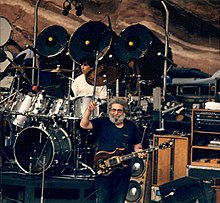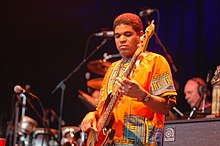Today is a complete rant about nothing car or bus related. Enjoy or ignore. Either way, I'm sure this will upset someone. To keep things calm, I will turn off the ability to add comments to this post.
Who the Hell Do I Think I Am?

Before Jerry Garcia died, self-identifying as a DeadHead was similar to self-identifying with a national (US) political party. People knew where you were coming from. You're not a metalhead, not a jazz aficionado and not a generic "fossil-rock" or classic rock fan. Being a DeadHead was specific. Nowadays, similar to identification with a political party, self-identifying as a DeadHead is not so simple. Like the many versions of political thought within a single party, there are many versions of "Dead fan" under the DeadHead banner. I know 'heads who feel that once Jerry died, it all changed and they'd never go to see a fragment of the Dead. There are those who will reflect on earlier days believing that things were better when (insert non-Jerry former member name here) was with them. There are some who will twirl to the sound of a child banging pans together. For others, all you need is a shuffle beat and it's worthy of praise, whether its a Dead fragment or a couple folks hammering on guitars in the parking lot. For the most part, all sides tend to agree that being off key or having some difficulty instrumenting doesn't matter. It's all good if you're groovy. Do whatever you're doing, but be genuine, push your limits and keep improving.

I'm somewhere in the middle of all that. I guess, if pressed, I'm sort of in that second group of 'they were better when'. Let me explain. I started following the Grateful Dead in the 80's, and my last tour with Jerry was in 1992. Except for my first few shows, I went to every show completely sober and danced my ass off. I missed the mid-90's through the early 2000's, picking back up with The Dead in 2009 and catching about a dozen Furthur shows before they stopped. I was at the JGB show in Milwaukee, WI that was just released on CD, drove overnight from Las Vegas to SF for the Golden Gate Park memorial when Bill Graham died and spent my honeymoon in 2012 (thx, Boo) witnessing the final New Years Eve run any Dead fragment performed.
So, who the hell am I? I'm someone who listened. I completely enjoyed every nuance of what greatness came from the stage and endured every plain-Jane set list, missed vocal note, and missed lyric, knowing more greatness would follow, and danced on. For that reason, I've waited 2 years for Dead and Company to follow the mess they create nightly with some greatness. It hasn't happened yet, and I don't think it will. Today's searing post details why I think that. Honestly, if this assemblage of players toured under a name that didn't have the word "Dead" in it, they would be playing bars, not stadiums. Agree or don't, but I have to get this out of my head.
Phil

Let's start with what's missing: Phil Lesh. He's the soul, the last remaining member truly believing that when the music leaves the speakers its everyone's. He embodies the freedom that the Grateful Dead packaged and delivered. As a player, Phil approaches the bass like it was a lead jazz instrument unlike just about everyone else who plays bass as part of a group. He is able to lead a group of musicians from song to song with little more than an encouraging smile (see photo) and a few little teases on the strings. He doesn't seem to approach the same chord change the same way twice, each time coming at the shift from a different angle, keeping the underpinnings of a song fresh and interesting. Sometimes, these experiments don't go as planned, but the experienced players he surrounds himself with are able to adjust and move with it. This was true with the Grateful Dead, the fragments of the Dead he worked with as well as his most current projects. While his voice hasn't been a benefit to any group of musicians he's played with for a long time, it was actually better during the Furthur days than it was for many years before or since.
Bob
Moving on to what's wrong, listen to a bootleg from just 10 years ago. Bob used to sing. Black-Throated Wind, Cassidy, Sugar Magnolia were some of the nicest vocal lines in the Dead songbook with his name on them. Check
this video or
this video from '78, for examples. Such sweet and powerful vocals. Sure, that was 40 years ago, and he was a much younger man, but now, he does a blend of barking, yelling and talking. He doesn't even try to make it sound like how the songs go, or to even sound like singing for that matter. So, while Phil's singing may not exactly be in tune, at least he's singing and trying to stay true to the melodies as best his voice can.
Bob's guitar work, however, remains just as interesting as it was in the 70's, only ripened with age. He voices chords and plays poly-rhythms in an extremely unusual way and he attracts players like bees to fresh flowers because of his innovative approach to the guitar. His bark-yelling the words to songs that used to have beautiful melodies, on the other hand, is just atrocious.
Drumming

In their hay-day, Billy and Mickey were able to set a groove. Sometimes the songs moved their beat and other times their beat moved the songs. The early half of "Drums" was one of my favorite and arguably most consistent spots for a show. It was highly rhythmic, encouraging dance like a tribal beat does. If a show was exceptionally plain-Jane, it was often this part of the show that turned it around. You could feel a hum-drum show turn. Something great would flow out of Space, completing the show with a strong handful of songs all thanks to Drums pulling the concert out of the bin.
After not playing together for a few years (since Rhythm Devils split in '08 and The Dead stopped in 2010), I figured it would take a while before Billy and Mickey hit their stride. Unfortunately, they still haven't and it's been long enough for them to get it together. There are definitely two drummers, not two instrumentalists making one rhythm. Perhaps they can't decide or agree on what they're doing. As a listener, it doesn't matter; they are less of a cooperative unit and more like two guys banging on things in the back. There are points when it sounds like there is a team of carpenters erecting a shed or drum-riser on stage rather than a cohesive percussive rhythm driving and complimenting the music.
John Mayer

One thing that sets Jerry Garcia's sound apart from everyone else, especially in the psychedelic space, is the most simple thing that John Mayer doesn't ever do: use the Mixolydian mode of the scale. Jerry didn't use it exclusively, but John never uses it. Ever. Even on the songs that cry out for it (The Other One or Terrapin, are examples, but there are plenty). He insists on only playing blues-style solos. That's great on Bobby's cowboy tunes or some older blues songs, but to only play that way against the Grateful Dead songbook feels like you're petting the fur the wrong way most of the time. When Warren Haynes toured with the Dead, he was able to bridge the gap from classic rock / blues to shred on some of the more psychedelic numbers. So, it can be done; John Mayer hasn't shown that he can, but then he's no Warren Haynes either. Of all the things that are wrong, John's approach to solos is the back-breaker for me. It just doesn't work in so many songs, I just can't take it.
John can sing (yeah, that's hardly news given his Grammy's). It's on key and pure. It just sounds a little old-style crooner which makes Dead tunes sound contrived, and the lyrics less powerful. Just as Aerosmith has to be sung with a little edge in the voice, the Dead can't be sung by Mel Torme. To me, it needs an edge; it needs a little sorrow. One cover song here or there is one thing. Singing half of a show without that soul just doesn't work.
Oteil
Oteil has a great voice. I hadn't heard him sing before last Summer and it is just beautiful. He sang a "China Doll" that was just amazing. When contrasted by Bob barker, I can't help but wonder why Oteil doesn't sing more and Bob sing less. It would probably make his main job (playing bass) much harder.
That bass work is just not the same as with Phil. Unlike Phil, Oteil plays like bass is a complimentary instrument that doesn't have much freedom. It's almost as if he had spent the last 20 years playing in a classic rock band. Oh yeah, he did. With the Allman Brothers. Yes, there are fills and runs here and there reflective of his years with the Aquarium Rescue Unit, but nothing like an old "Phil and Ned" or even some of the tasty lines Phil would drop into more straight-forward numbers like Scarlet or Music Never Stopped. But, Oteil has it in him to get out of the box. The guy can totally groove; I don't know how much freedom he has to do so in this group for two reasons. First, he is in a rhythm section comprised of him and the carpenters I described above. To keep the song together, he really can't move too far from dead-center or the shed construction could completely unravel a song while he is pushing the creative envelope. Second, Bob will need to let Oteil loose. Having watched video of Bob working with other players, I know he runs a tight ship. But having so much of the responsibility for keeping the song together may be the true barrier to Oteil really blowing some minds.

Jeff
I haven't mentioned Jeff Chimenti, and I really should. He's fantastic. Really fantastic. Really really fantastic. He's been playing with members of the Dead for 20 years, and he totally gets it. I first caught him with The Dead and have enjoyed every show I've seen him play since. In my mind, he's reached, and maybe surpassed "Brent status" in terms of his keyboard. On those occasions when I gave Dead and Company a try, it was Jeff's keyboard work that kept me listening well beyond my patience would allow had he not been crushing it so hard. He is simply inspired. I hope to see the
Golden Gate Wingmen one of these days to see how he and JohnK play together in their new group. And maybe hear what some of his original material is like? That would be so great. Okay, I've run out of descriptors. Let's just summarize with: he's awesome.
That's my rant for today. I'll get back to my usual car or bus work and road trips next time. Thanks for bearing with me, and if there's a jam band that you like (that's
not Dead and Company), I'd love to hear them. I'll be trying on String Cheese this summer, and really want to hear whatever else is going on in the jam-band space. Have bus, will travel-
---
2023-August days-between update... now that Dead & Co's final tour has ended, I am hopeful for the next incarnation. I had not been following the news items about them, so I missed the part where they parted ways with Billy, leaving only Bob and Mickey as original members. Arguably, Mickey was a later addition, but lets not split hairs. I heard some of the final tour, and the new drummer was great. Awesome energy and ticking like a flippin clock. It seems like the "creative differences" between Dead & Co and Billy may have been Billy's contribution to the drum riser construction I mentioned above, seeing how it was not going on anymore. Also, Oteil was WAY more active and present, implying that my theory that he was under-playing just to hold things together may have been somewhat on-target. Anyway, RIP Dead & Co, and may a greater phoenix rise from these ashes, preferably without John Mayer. Musing... maybe just swap out JohnM for JohnK and drop the word "Dead" from the name so they aren't playing stadiums full of 50k persons chasing their personal pasts. Instead, they can return to more intimate venues like Further played, and return to the experimentation we got to witness in doing so. One can dream.




















